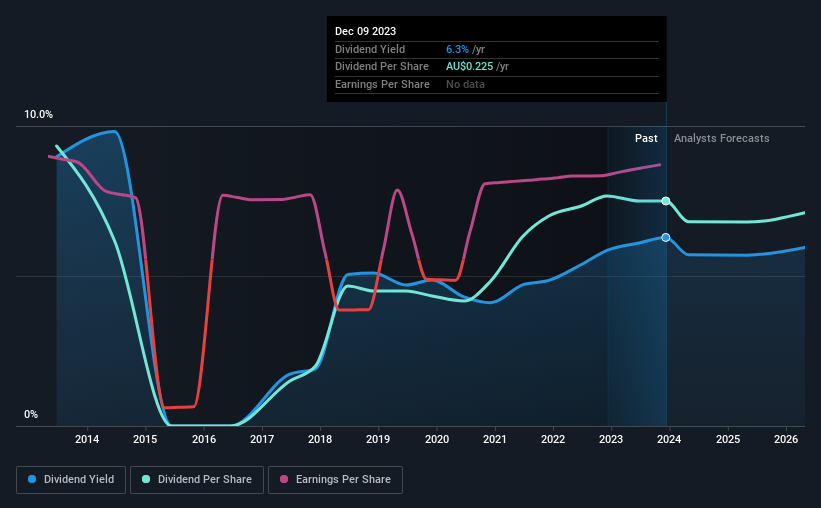Metcash Limited (ASX:MTS) is about to trade ex-dividend in the next 4 days. The ex-dividend date is usually set to be one business day before the record date which is the cut-off date on which you must be present on the company’s books as a shareholder in order to receive the dividend. The ex-dividend date is an important date to be aware of as any purchase of the stock made on or after this date might mean a late settlement that doesn’t show on the record date. Meaning, you will need to purchase Metcash’s shares before the 14th of December to receive the dividend, which will be paid on the 30th of January.
The company’s next dividend payment will be AU$0.11 per share, on the back of last year when the company paid a total of AU$0.23 to shareholders. Looking at the last 12 months of distributions, Metcash has a trailing yield of approximately 6.3% on its current stock price of A$3.58. Dividends are an important source of income to many shareholders, but the health of the business is crucial to maintaining those dividends. So we need to check whether the dividend payments are covered, and if earnings are growing.
See our latest analysis for Metcash
Dividends are usually paid out of company profits, so if a company pays out more than it earned then its dividend is usually at greater risk of being cut. Its dividend payout ratio is 78% of profit, which means the company is paying out a majority of its earnings. The relatively limited profit reinvestment could slow the rate of future earnings growth. We’d be worried about the risk of a drop in earnings. Yet cash flows are even more important than profits for assessing a dividend, so we need to see if the company generated enough cash to pay its distribution. It distributed 47% of its free cash flow as dividends, a comfortable payout level for most companies.
It’s positive to see that Metcash’s dividend is covered by both profits and cash flow, since this is generally a sign that the dividend is sustainable, and a lower payout ratio usually suggests a greater margin of safety before the dividend gets cut.
Click here to see the company’s payout ratio, plus analyst estimates of its future dividends.
Have Earnings And Dividends Been Growing?
Companies with consistently growing earnings per share generally make the best dividend stocks, as they usually find it easier to grow dividends per share. If business enters a downturn and the dividend is cut, the company could see its value fall precipitously. That’s why it’s comforting to see Metcash’s earnings have been skyrocketing, up 37% per annum for the past five years. Earnings per share are growing at a rapid rate, yet the company is paying out more than three-quarters of its earnings.
The main way most investors will assess a company’s dividend prospects is by checking the historical rate of dividend growth. Metcash’s dividend payments per share have declined at 2.2% per year on average over the past 10 years, which is uninspiring. Metcash is a rare case where dividends have been decreasing at the same time as earnings per share have been improving. It’s unusual to see, and could point to unstable conditions in the core business, or more rarely an intensified focus on reinvesting profits.
Final Takeaway
Is Metcash an attractive dividend stock, or better left on the shelf? We like Metcash’s growing earnings per share and the fact that – while its payout ratio is around average – it paid out a lower percentage of its cash flow. It’s a promising combination that should mark this company worthy of closer attention.
While it’s tempting to invest in Metcash for the dividends alone, you should always be mindful of the risks involved. For example, we’ve found 1 warning sign for Metcash that we recommend you consider before investing in the business.
A common investing mistake is buying the first interesting stock you see. Here you can find a full list of high-yield dividend stocks.
Have feedback on this article? Concerned about the content? Get in touch with us directly. Alternatively, email editorial-team (at) simplywallst.com.
This article by Simply Wall St is general in nature. We provide commentary based on historical data and analyst forecasts only using an unbiased methodology and our articles are not intended to be financial advice. It does not constitute a recommendation to buy or sell any stock, and does not take account of your objectives, or your financial situation. We aim to bring you long-term focused analysis driven by fundamental data. Note that our analysis may not factor in the latest price-sensitive company announcements or qualitative material. Simply Wall St has no position in any stocks mentioned.


